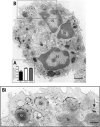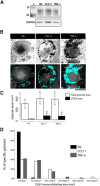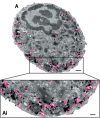CD63 is tightly associated with intracellular, secretory events chaperoning piecemeal degranulation and compound exocytosis in human eosinophils
- PMID: 26965633
- PMCID: PMC6608091
- DOI: 10.1189/jlb.3A1015-480R
CD63 is tightly associated with intracellular, secretory events chaperoning piecemeal degranulation and compound exocytosis in human eosinophils
Abstract
Eosinophil activation leads to secretion of presynthesized, granule-stored mediators that determine the course of allergic, inflammatory, and immunoregulatory responses. CD63, a member of the transmembrane-4 glycoprotein superfamily (tetraspanins) and present on the limiting membranes of eosinophil-specific (secretory) granules, is considered a potential surface marker for eosinophil degranulation. However, the intracellular secretory trafficking of CD63 in eosinophils and other leukocytes is not understood. Here, we provide a comprehensive investigation of CD63 trafficking at high resolution within human eosinophils stimulated with inflammatory stimuli, CCL11 and tumor necrosis factor α, which induce distinctly differing secretory processes in eosinophils: piecemeal degranulation and compound exocytosis, respectively. By using different transmission electron microscopy approaches, including an immunonanogold technique, for enhanced detection of CD63 at subcellular compartments, we identified a major intracellular pool of CD63 that is directly linked to eosinophil degranulation events. Transmission electron microscopy quantitative analyses demonstrated that, in response to stimulation, CD63 is concentrated within granules undergoing secretion by piecemeal degranulation or compound exocytosis and that CD63 tracks with the movements of vesicles and granules in the cytoplasm. Although CD63 was observed at the cell surface after stimulation, immunonanogold electron microscopy revealed that a strong CD63 pool remains in the cytoplasm. It is remarkable that CCL11 and tumor necrosis factor α triggered increased formation of CD63(+) large vesiculotubular carriers (eosinophil sombrero vesicles), which fused with granules in the process of secretion, likely acting in the intracellular translocation of CD63. Altogether, we identified active, intracellular CD63 trafficking connected to eosinophil granule-derived secretory pathways. This is important for understanding the complex secretory activities of eosinophils underlying immune responses.
Keywords: cell secretion; immune responses; inflammation; transmission electron microscopy; vesicular trafficking.
© Society for Leukocyte Biology.
Figures








Similar articles
-
Vesicle-mediated secretion of human eosinophil granule-derived major basic protein.Lab Invest. 2009 Jul;89(7):769-81. doi: 10.1038/labinvest.2009.40. Epub 2009 Apr 27. Lab Invest. 2009. PMID: 19398958 Free PMC article.
-
Intragranular vesiculotubular compartments are involved in piecemeal degranulation by activated human eosinophils.Traffic. 2005 Oct;6(10):866-79. doi: 10.1111/j.1600-0854.2005.00322.x. Traffic. 2005. PMID: 16138901 Free PMC article.
-
Expression and subcellular localization of the Qa-SNARE syntaxin17 in human eosinophils.Exp Cell Res. 2015 Oct 1;337(2):129-135. doi: 10.1016/j.yexcr.2015.07.003. Epub 2015 Aug 6. Exp Cell Res. 2015. PMID: 26254897 Free PMC article.
-
Contemporary understanding of the secretory granules in human eosinophils.J Leukoc Biol. 2018 Jul;104(1):85-93. doi: 10.1002/JLB.3MR1217-476R. Epub 2018 May 11. J Leukoc Biol. 2018. PMID: 29749658 Free PMC article. Review.
-
Mechanisms of eosinophil secretion: large vesiculotubular carriers mediate transport and release of granule-derived cytokines and other proteins.J Leukoc Biol. 2008 Feb;83(2):229-36. doi: 10.1189/jlb.0707503. Epub 2007 Sep 17. J Leukoc Biol. 2008. PMID: 17875811 Free PMC article. Review.
Cited by
-
Vesicular trafficking of immune mediators in human eosinophils revealed by immunoelectron microscopy.Exp Cell Res. 2016 Oct 1;347(2):385-90. doi: 10.1016/j.yexcr.2016.08.016. Epub 2016 Aug 22. Exp Cell Res. 2016. PMID: 27562864 Free PMC article. Review.
-
The Enigma of Eosinophil Degranulation.Int J Mol Sci. 2021 Jun 30;22(13):7091. doi: 10.3390/ijms22137091. Int J Mol Sci. 2021. PMID: 34209362 Free PMC article. Review.
-
Recent advances in understanding eosinophil biology.F1000Res. 2017 Jul 7;6:1084. doi: 10.12688/f1000research.11133.1. eCollection 2017. F1000Res. 2017. PMID: 28751971 Free PMC article. Review.
-
Eosinophils in the Field of Nasal Polyposis: Towards a Better Understanding of Biologic Therapies.Clin Rev Allergy Immunol. 2022 Feb;62(1):90-102. doi: 10.1007/s12016-021-08844-7. Epub 2021 Jan 26. Clin Rev Allergy Immunol. 2022. PMID: 33496939 Review.
-
Eosinophil extracellular traps in respiratory ailment: Pathogenic mechanisms and clinical translation.World J Otorhinolaryngol Head Neck Surg. 2023 Nov 1;10(3):213-224. doi: 10.1002/wjo2.138. eCollection 2024 Sep. World J Otorhinolaryngol Head Neck Surg. 2023. PMID: 39233861 Free PMC article. Review.
References
-
- Stow, J. L. , Murray, R. Z. (2013) Intracellular trafficking and secretion of inflammatory cytokines. Cytokine Growth Factor Rev. 24, 227–239. - PubMed
-
- Melo, R. C. N. , Dvorak, A. M. , Weller, P. F. 2012. Eosinophil ultrastructure In Eosinophils in health and disease. (Lee J. R., Rosenberg H., eds.), Vol. 1 Elsevier, New York, p. 20–27.
-
- Inoue, Y. , Matsuwaki, Y. , Shin, S. H. , Ponikau, J. U. , Kita, H. (2005) Nonpathogenic, environmental fungi induce activation and degranulation of human eosinophils. J. Immunol. 175, 5439–5447. - PubMed
Publication types
MeSH terms
Substances
Grants and funding
LinkOut - more resources
Full Text Sources
Other Literature Sources
Miscellaneous

